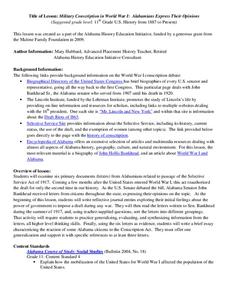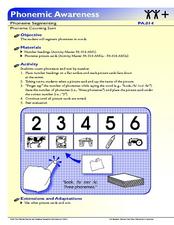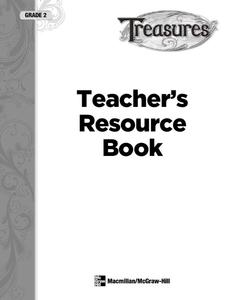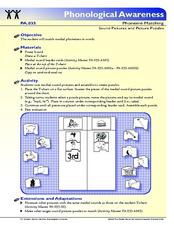Florida Center for Reading Research
Phonics: Letter-Sound Correspondence, Where's That Sound?
The phoneme train is leaving the station! Get your budding readers familiar with letter-sound correspondence using this fun phonics activity. Learners set up the initial and final sound train cards, placing letters between them. They...
Florida Center for Reading Research
Phonics: Letter-Sound Correspondence, Letter-Sound Folder Sort
Practice letter-sound correspondence using an activity that challenges pupils to sort images based on their final sounds. Pairs choose four final sounds to place in an open file folder, take turns selecting image cards, pronouncing the...
Florida Center for Reading Research
Phonological Awareness: Phoneme Matching, Vowel Picture Sort
Sound sorting can be a fun way to get little ones phonologically prepared for a life of reading. In this activity, learners sort picture cards based on the long or short vowel sound they make when said aloud.
Florida Center for Reading Research
Phonics: Letter-Sound Correspondence,
What a fun way to practice medial sound-letter correspondence! This alphabet activity has pupils flip cards, determine the medial sound, and place it on one of the train cars if it matches.
Alabama Department of Archives and History
Military Conscription in World War I: Alabamians Express Their Opinions
If called, would you go? Should the US government have the power to impose a draft during any war? The Selective Service Act of 1917 (aka the Conscription Act of 1917) authorized the drafting of men into the military for only the...
Curated OER
Phonological Awareness, Phoneme Manipulating, Phoneme Position Sort
Scholars make new words out of old ones by manipulating phonemes. Pupils mix and match initial, medial, and final phonemes to change words like cap into cup or head into bed.
Florida Center for Reading Research
Phonemic Awareness: Phoneme Segmenting, Phoneme Counting Sort
Pre-readers use the provided cards to say and sort based on the number of phonemes in each word.
Florida Center for Reading Research
Phonological Awareness: Rhyme, Rhyme Closed Sort
A rhyming activity challenges scholars to sort picture cards according to their rhyme. Four picture cards line up across the top of a pocket chart. Learners take turns choosing from a face-down stack of picture cards and sort them...
Curated OER
Vocabulary Instruction: Identify and Sort Common Words into Categories
Kids learn about the concept of nouns. They practice identifying nouns by sorting words into categories. As the teacher holds up each word, the class reads it in unison, then they take turns identifying it as a noun or non noun word....
Florida Center for Reading Research
Phonological Awareness: Phoneme Matching, Sound Maker - Sound Smacker
Scholars sort words based on their initial phonemes. They choose cards, say their names, and match the initial phoneme to the one posted on one of the sorting bins. If the initial sound matches, they put the card in the sound maker bin,...
Florida Center for Reading Research
Phonics: Encoding and Decoding, Letter Cube Blending
Emergent readers use a letter cube to identify, blend, and make words. They roll each of the three-letter cubes, mark down the letters they rolled, then blend the letter sounds together to make a word. They record each word on a...
Florida Center for Reading Research
Sound it-Bag it
Scholars sort picture cards based on the initial phoneme they hear as they say the name of each image. They pick a card, say its name, then place it in one of five bags based on how its initial phoneme matches the initial phoneme...
Florida Center for Reading Research
Phonological Awareness: Phoneme Matching, Sound Train
Make a phonics train filled with matching initial phonemes. Early readers say the name of the objects on each of their cards, identify the initial letter sounds or phonemes, then paste them on a train. They make three trains, which means...
Florida Center for Reading Research
Phonological Awareness: Phoneme Matching, Pack-a-Backpack
Scholars sort words based on their initial phoneme or sound. Learners are given two backpacks, each with a picture card; they search and match picture cards with the same initial sound as the ones on each backpack.
McGraw Hill
Phonics Teachers Resource Book
Looking to improve your classes literacy program? Then look no further. This comprehensive collection of resources includes worksheets and activities covering everything from r-controlled vowels and consonant digraphs, to the...
EngageNY
Mid-Unit 2 Assessment: On-Demand Informational Writing
Lesson 7 focuses on building academic vocabulary and writing an explanatory letter with supported textual evidence. For the first five minutes of the lesson, the educator reminds the class of how to read and refer to the accordion...
Florida Center for Reading Research
Phonological Awareness: Phoneme Matching, Medial Match
Early readers get together and match medial phonemes. They take turns picking picture cards from a pile; they say each word, then determine whether the pair has matching medial sounds.
Florida Center for Reading Research
Phonemic Awareness: Phoneme Matching, Sound Pictures and Picture Puzzles
Scholars use a T-chart and puzzle pieces to practice saying and recognizing the medial sound in a series of words. Peers take turns choosing a puzzle piece, saying its name and medial sound, then placing it on their side of the chart.
Curated OER
Organizing Writing to Convey a Central Idea
Fourth and fifth graders practice the skill of organizing their writing to convey a central idea by sorting 14 facts about the dogwood tree into four categories of facts. The categories, which are written on the board, are; Governmental...
Florida Center for Reading Research
Advanced Phonics: Syllable Patterns, Syllable Game
A game designed to support advanced phonics instruction challenges scholars to read and break a word into syllables. If the player is correct, they move their game piece forward on the board. Whoever gets to the end first wins!
Scholastic
Digraph sh
Shhhh! Listen up to learn about the sh digraph. With the materials provided here, kids will have the opportunity to hear, say, write, and read this particular digraph many times.




















